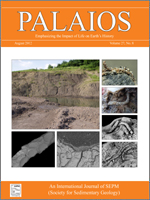Skeletal remains of woolly mammoths have been studied using polarizing microscopy, SEM, XRD, and FTIR to characterize their diagenetic history. Formation of different secondary minerals in the bones is related to changing conditions of chemical diagenesis, both in the sediment and in the bone itself. Bone voids are commonly infilled with calcite and/or carbonate sediment, and dentinal tubules are coated or infilled with secondary apatite. The latter may have formed during the life of the organism. Some osteocyte lacunae were observed to be coated with Fe-Mn (hydroxy)oxides. The average hydroxylapatite Ca/P ratios are higher (1.78–2.10) than in stoichiometric hydroxylapatite. Hydroxylapatite crystallinity indices are generally low at 0.06–0.12, as expected for the young bones. Some of the bones are partly altered by microbial attack. Different postdepositional events affecting the bones (recrystallization of apatite, bacterial alterations, mineral and sediment infillings and cracking) were distinguished and their succession proposed.
How to translate text using browser tools
1 August 2012
DIAGENETIC HISTORY OF WOOLLY MAMMOTH (MAMMUTHUS PRIMIGENIUS) SKELETAL REMAINS FROM THE ARCHAEOLOGICAL SITE CRACOW SPADZISTA STREET (B), SOUTHERN POLAND
ANNA ROGOZ,
ZBIGNIEW SAWLOWICZ,
PIOTR WOJTAL
ACCESS THE FULL ARTICLE
It is not available for individual sale.
This article is only available to subscribers.
It is not available for individual sale.
It is not available for individual sale.

PALAIOS
Vol. 27 • No. 8
August 2012
Vol. 27 • No. 8
August 2012




